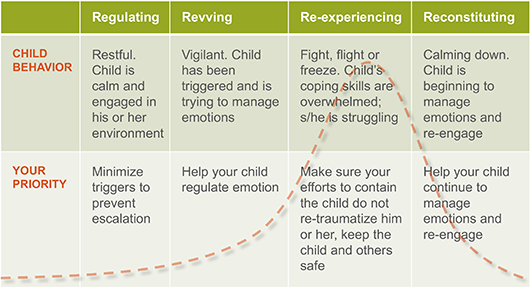TST-FC: Helping Caregivers Understand Trauma’s Impact on Children

For children who have experienced trauma, a seemingly unremarkable detail — the smell of cigarette smoke, an incidental touch or the sound of someone’s accent — can trigger a “fight, flight or freeze” reaction that can seem like misbehavior, insolence or worse to kin or foster parents.
“Some caregivers think, ‘I can’t deal with these kids,’ and they leave foster parenting,” says Tracey Feild, managing director of the Casey Foundation’s Child Welfare Strategy Group. “The toll on kids is terrible: They not only have to change homes, but they begin to believe they are unworthy of an adult’s love and attention. Their belief in themselves suffers; so does their schoolwork and relationships with others.”
To help foster parents understand kids in their care, keep kids from moving from one foster home to another and reduce turnover among caregivers, the Foundation has supported development of Trauma Systems Therapy for Foster Care (TST-FC).
Stages of Behavior (The Four Rs)

“TST-FC provides caregivers with the skills to understand that their child is not being defiant or violent for no reason,” Feild says. “The curriculum gives foster parents a process for evaluating what happens before a child melts down, so caregivers can more easily identify triggers and learn how to avoid them.”
The TST-FC training curriculum is available online without charge. It provides child welfare agencies with a powerful tool to help caregivers recognize and meet the needs of kids and teens who have experienced trauma. The curriculum includes detailed facilitator guides, training presentations, handouts and a foster parent resource guide. During TST-FC’s four interactive group sessions, facilitators guide caregivers through role playing, hands-on exercises and reflective conversations to connect what has happened in a child’s life to his or her behavior. Foster parents practice skills such as de-escalating difficult behavior, helping a child regroup after a meltdown and recognizing when a child is being reminded of a traumatic experience.
The Impact of Trauma, the facilitator guide for TST-FC’s first session, introduces caregivers to the physical, mental and emotional effects of trauma. It starts by defining trauma as “a life-threatening or extremely frightening experience — for the child or someone they care about — that overwhelms the child’s capacity to cope.” It also covers:
- Prevalence: Nearly half of children from birth to age 17 have experienced at least one type of trauma.<.li>
- Types of trauma:
- Acute: a single, time-limited event (such as a car accident)
- Chronic: repeated abuse or neglect
- Complex: a subgroup of chronic trauma that occurs before the age of 5 and that interferes with healthy brain development
- Survival-in-the-moment states: a terrifying experience — or a reminder of trauma — that triggers a fight, flight or freeze reaction
- Trauma reminders: the “cat” (actual threat of harm) and the “cat hair” (reminders of dangers)
- The four stages of children’s behavior: regulating, revving, re-experiencing and reconstituting
The TST-FC curriculum was written by Kelly McCauley of KVC Health Systems, Inc., with consultation from Dr. Glenn Saxe of NYU Langone Health. It was tested in two public child welfare agencies and a private provider system and evaluated by ChildTrends.





